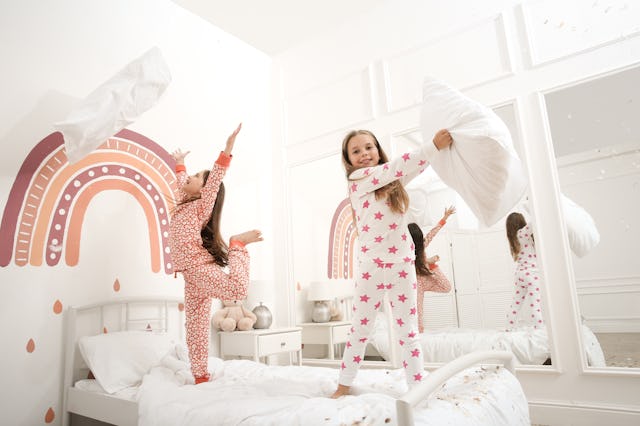These Shared Bedroom Ideas Could Help You Avoid A Battle Royale Between Your Kids
No, you can’t just draw a line down the center of the room.

For many families, housing accounts for the largest portion of their overall living expenses. And because space comes at a premium, having kids share a bedroom just makes sense. While finances might be only one reason for going this route, there are many pros, including a stronger bond between siblings. Still, making these spaces as functional as possible is key to making this setup a success. Otherwise, you run the risk of your kids going all Mad Max Thunderdome on each other.
To that end, Scary Mommy tapped Jennifer J. Morris, principal at JMorris Design LLC, for her expert tips on the best setups for shared kids' bedrooms.
What are the best setups for shared kids' bedrooms to maximize space?
According to Morris, bunk beds are the way to go if maximizing space is the priority and will make the room feel larger and allow more room for playing — but keeping your lifestyle in mind when choosing this setup is a must for making it work for your family.
"Bunk beds max the room you have left over, but you have to keep in mind, beyond the fighting about who gets which bed, the other day-to-day logistics. If you snuggle or read to your child in bed, the top bunk becomes a challenge, and I dare say, a hazard with two on top," says Morris, adding that parents should also consider safety. "You also need to be sure your child has the self-control and body awareness that being five feet off the ground requires. If you have a busy body, bathroom urgencies, or a kid that might rough house a bit too much with friends and siblings, the bunk bed can be a stressor."
If you have a larger room to work with, Morris said placing separate twin or even full beds at each end of the room can give kids a sense of having their own space while still providing a centralized area for play or just breathing room.
Trundles are another stacked bed option. However, they're not as sibling-friendly as they might seem. "I think it's best to keep [trundles] for friends and not a sibling who would feel like they don't have a reliable place to rest and regroup if it's tucked away. And being that close to a sibling without some reprieve seems like a bad idea," explains Morris.
Photo credit: JMorris Design LLC
Photo credit: JMorris Design LLC
What are some tips for creating a space that feels individualized to each child, especially when siblings have differing styles due to age gaps or gender?
As kids get older, a bedroom becomes a place for them to express themselves. And when it's a shared bedroom, interests and styles can clash, causing big drama — drama Morris says can be toned down with the help of customized built-ins or even simple solutions in the form of budget-friendly room dividers, like curtains or bookcases.
"I have made custom platform beds that go wall-to-wall above another bed below. This loft-type construction creates two levels and zones so the kids feel they can decorate the walls around them and the ceiling (or below the platform) to get creative and expressive in their own areas," says Morris.
Aware that customizable solutions aren't an option for every family, Morris says that even their own wall area to pin up art, or dividing up the shelves on a bookcase where they can place their things, can give kids a similar sense of having their own space.
Photo credit: JMorris Design LLC
What should parents consider before planning out a shared kids' bedroom?
It's better to go into the room redecorating or renovating process with a plan — or at least the answers to a few pertinent questions. A few things to consider:
- Are your children responsible enough to be on a top bunk?
- Are your children fully potty-trained?
- Do your children frequently wake in the middle of the night?
- Do your children have similar sleep schedules?
- What are your children's interests? (Do they love to read or have lots of toys?)
- Are your children calm vs. active?
- What is your family's design- and lifestyle?
- Do you rent or own your home?
And, unless you're planning to surprise your kids with a room makeover, sit them down for a conversation. "Be honest about who your kids are and how they need to feel comfortable. Make a chart and prioritize needs and wants to get to the core of what really should make it into the room. Let the kids get involved. If you are like most parents, you want them to love their room," says Morris.
This article was originally published on